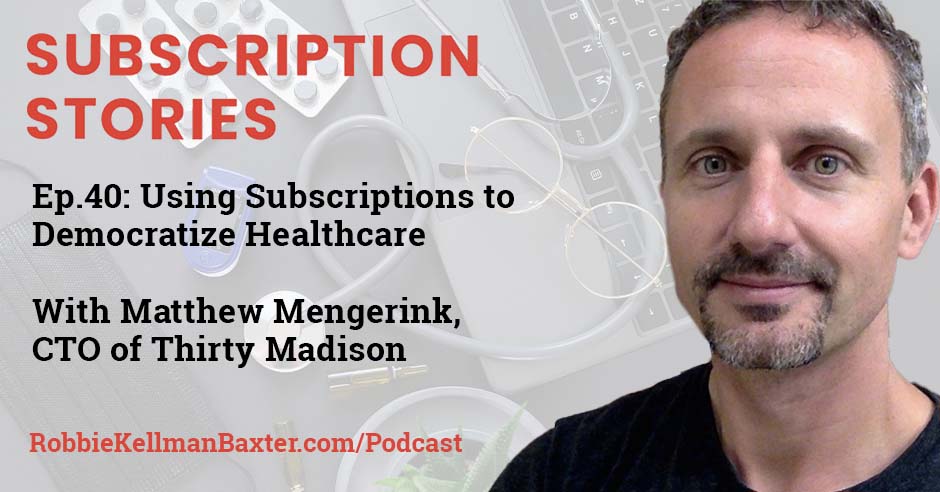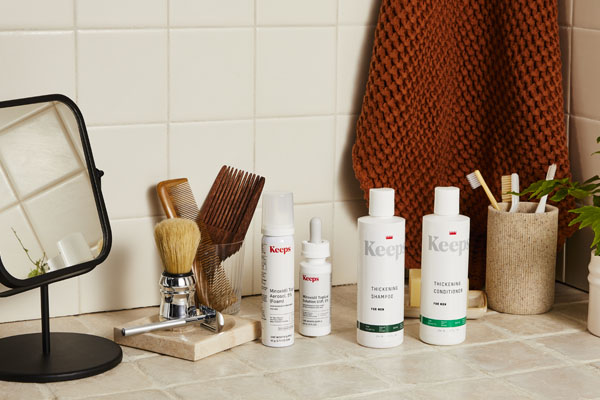
Nearly every industry can benefit from joining the Membership Economy, and most industries have great examples of subscription-based organizations. One of the slowest movers has been the healthcare industry and for good reason. There’s so much complexity to delivering health outcomes—as well as great risk. And that’s why I’m so excited about this episode of Subscription Stories. Today’s guest, Matthew Mengerink, is the Chief Technology Officer at Thirty Madison. The company describes itself as “the human-first health company bringing specialized care and treatment to everyone.” One by one, they are tackling some of the most challenging chronic health issues, like allergies, migraines, and hair loss, using a combination of digital and real-world services through “forever transactions” with the people they serve. In this conversation, Matthew and I talk about Thirty Madison’s uniquely scalable approach to healthcare, the challenges of balancing personalization with systems and protocols, and what subscriptions might mean for the future of medicine.
—
Listen to the podcast here:
Using Subscriptions to Democratize Healthcare with Matthew Mengerink, CTO of Thirty Madison
Nearly every organization can benefit from joining the membership economy and most industries have great examples of subscription-based organizations. One of the slowest movers has been the healthcare industry and for a good reason. There is so much complexity to delivering health outcomes as well as a great risk. That is why I am so excited about this episode.
Our guest, Matthew Mengerink is the Chief Technology Officer at Thirty Madison. This company describes itself as “the human-first health company, bringing specialized care and treatment to everyone.” One by one, they are tackling some of the most challenging chronic health issues like allergies, migraines and hair loss through forever transactions with the people they serve. By using a combination of digital and real-world services, they are hoping to democratize healthcare. In this conversation, Matthew and I talk about Thirty Madison’s uniquely scalable approach to healthcare, the challenges of balancing personalization with systems and protocols and what subscriptions might mean for the future of medicine.
—
Welcome to the show, Matthew.
Thank you so much for having me.
Let us start with the mission of Thirty Madison. Can you share a little bit about how Thirty Madison came to be? What you are trying to accomplish for your members?
Around 60% of all Americans have a chronic condition. These are affecting tens of millions of Americans on a daily basis. Of the $2.2 trillion that the US spends on healthcare every year, 75% of that is spent on chronic conditions so this is an enormous opportunity. If you look at that 60%, 40% have two or more chronic conditions.
What are chronic conditions?

Democratize Healthcare: Of the $2.2 trillion that the US spends on healthcare every year, 75% of that is spent on chronic conditions.
Somebody who is a migraine sufferer, who might have hair loss, gastrointestinal, Crohn’s disease, cardiovascular and musculoskeletal conditions where people injure a joint and suffer immobility for the rest of their lives. The list goes on and on. There are over 350 chronic conditions that are indexed and there are variations within each one of those.
I guess most people reading might have one or have a loved one who has one of those chronic conditions.
The probabilities are overwhelming for it.
What is Thirty Madison doing with regard to those chronic conditions that seem to affect so many people?
We envision a future where every American who copes with a chronic condition, eventually everyone in the world, can access highly affordable, high-quality care based on science to improve their lives. It is what drives us to expand our specialty level of care to the people who need it.
As somebody who looks at subscription models and thinks about missions and what I call forever promises that organizations make to their customers, members or subscribers. When it comes to forever promises that an organization can make, a promise of better and access to health is one of the most meaningful and, in almost all cases is an ongoing promise.
One of the challenges of the promise is the commitment to stay current with the science and the ever-changing backdrop of health. As you think about the changes in medicine and the advancement, we start to accelerate those like technology has accelerated over the last years. We have every expectation that we will have a year-by-year iteration of those promises.
One of the things that I have noticed with the industries that are being reinvented, and healthcare is a good example of this, is traditional healthcare organizations probably would say they have the same mission that Thirty Madison has, which is to provide access to ongoing treatment and healthcare to give people the best quality of life. Somewhere along the way, they stopped innovating, they slowed down on their innovation or they moved to a model where they are more focused on fixing things that are broken than they are about continually improving your quality of life and the number of happy minutes that a person can enjoy in their life.
We envision a future where every American who copes with a chronic condition, eventually everyone in the world, can access highly affordable, high-quality care based on science that can improve their lives. - @mengerin Share on XI appreciate what you said about this continuous improvement in the way you are delivering and also the point that you made, which I want to dig into a little bit about regulatory issues. Some of the best ways of helping people enjoy greater health were not available a few years ago. You guys are in a Wild West trying to figure out what is allowed and the best process. There are no playbooks to follow.
If we look at the prescriptive process of medicine, there is a great history and momentum, but if we talk about access to that care, specialized level telemedicine, personalized treatment and ongoing management, that is where a different approach has this greenfield opportunity. If you look at a hospital or a general practitioner’s office, any person walks in with any condition, there is the diagnostic process and the time it takes to schedule to wait and to travel. From there, you get an advancement or special treatment by getting referred to a specialist.
You are constrained by the benefits management and insurance of your company, oftentimes. As a process, this is very drawn out. When you get into one of these offices, they are trying to churn through as fast as they can to take care of people but their context and the medical records that they are able to look at, are fairly limited in some cases. The communication channel is not something you can take a record with you as you go.
The opportunity we have is the government has opened this up. It allows people to schedule things asynchronously and take the medical record to a specialist without these different layers. Personalization is much easier because as we have events that are triggering, we are using technology on our side to determine when somebody should see a specialist or reach out. A perfect example is somebody with a migraine. We have a condition tracker, which allows our patients to say, “I had a migraine. Here is how long it lasted and the level of intensity.” That data then feeds us a trigger or prompt to our models to say how severe and should we reach out.
Can we determine that it is time to change medicines on behalf of the patient? In a traditional context, it is all push. It is the patient reaching out when they think they have gone too far or the pain is too high.
We are turning it around and it is now doctors reaching out. It is a doctor scheduling with you on your time instead of vice versa. That is a very different model than what we have seen in the past.
If I am a member of Cove for migraines, I come in. I have access to an app and real doctors so it is a blended model.

Democratize Healthcare: The democratization comes from an understanding and applicability that’s on equal footing so that everyone has access to the same care on their own terms.
It is the combination of digital therapeutic and human so it is the best of both worlds instead of the worst. The thing that makes things more efficient is the technology and the things that allow us to catch something that a human might miss. Humans are a little sloppy from time to time with the best of intentions. We know that accidents happen but in analytical contexts, computers are not flawless because they are not flawless by design but operationally, they do not miss things. If you are looking at medication interaction or keywords like pregnancy, there are certain migraine medications that you cannot use while pregnant.
You do not want to miss that word and have a computer there to augment or look at the context of the patient and summarize that concisely then turns into the judgment of a human that is better informed and is proactively reaching out to the patient to say, “Now might be a time to change the medicine or the medicine you have has negative interactions with other medicines or other conditions you are suffering.” That, to me is the perfect blend of tech and people.
You are the Chief Technologist at Thirty Madison. Your job is to help figure out what kinds of technology can be used to provide that ongoing monitoring recommendation and care in conjunction with medical professionals. You have always been in that space, the technologist and have worked at some of the most innovative technology companies in the world. How is it different working hand-in-hand with physicians and medical professionals?
If there is a commonality to the places I have worked, it has been this: tech-centric company and very complex ecosystems. Generally, they are multiparty. For example, on YouTube, we would have creators, viewers, corporations, advertisers, agencies, labels and so on. There is this beautiful mix and you work to reduce that complexity. If we think about Uber, transportation, cars, different compliance of different cities and airports, there is complexity there. In each of those scenarios, there is a very general experience and convenience is on the line. I would argue that Uber has safety but if you cannot play your playlist for music on YouTube, it is disappointing.
Thirty Madison raises the stakes completely. The complexity can be on a city level. On a city level, you can get into different compliance aspects of medicine, different age groups, medical programs, insured, uninsured, pharmacy benefits management versus the insurer and who is covering what and how much. The complexity is overwhelming.
I have never met a person who has said, “Is health insurance easy for you?” They go, “That is a piece of cake and I love it.” You have difficulty there. You have the ability to have physicians in their licensing. The constraint there is HIPAA compliance that you have to deal with. It is an overwhelmingly large amount of details. When you want to do something easily, may or may not is a much more complex question within Thirty Madison. It is beyond just serving the patient directly.
What we try to do and the excitement of this from a technical perspective is to create the safe rails so that an engineer and a product person, when they are thinking about delivering the best, most bespoke care and treatment without advertisement, distraction, just that loving relationship between the clinician and patient, doing so in a way that we can think generally and the rest of the system takes care of the compliant constraints that the right questions are asked.
We're turning it around now. It is now doctors reaching out. It's a doctor scheduling with you on your time instead of vice versa. - @mengerin Share on XIf it is synchronous care, that is a format that is used. The underlying principles of science, health and the individual background is immediately in that moment. That is tremendously exciting. That is beyond anything that I have seen before, trying to do at scale with hundreds of millions of people as an opportunity.
It is very complicated. I love that you are saying it is exciting. It seems daunting to me to make all of those things work together. From a tech perspective, you are using machine learning, CBT and digital content feedback loops. Is it the same tools you have used in other roles or applied differently and with more constraints and challenges or are there new tools and approaches that you need to use in this healthcare context?
If you take machine learning, there are platforms that deliver the framework. We can borrow against those frameworks. I am sure you have heard that machine learning is racist and aggressive that these are different things that are heard. I do not know that we should subscribe those terms to computers but what is implicit is that machine learning extraordinarily quickly targets metrics and delivers something very efficiently faster than people and we will take what we perceive as an aggressive path towards it.
If there is any bias in a system, machine learning minds that bias and expand it very quickly. If there is a racial inequality or racist perspective in the designer that has a bias in a system like benefits of a wealthy person versus the non-wealthy, you could get into the inner city and suburban disparity. Those factors come into play extraordinarily quickly and create disparity. Even if it creates success for a company, it creates a disparity in the offering for the customer and our case, the patient.
The DEI constraints of machine learning have a priority and importance here that I have not seen elsewhere that it lives day-to-day within each group, ensuring that we are taking into consideration our targets so that our value of healthcare for all is maintained in every single nuance and algorithms. Again, it is a tough place to do it because we do not talk enough about the ethics of delivery of a subscription and the ethics of the value of the services being delivered. Amongst the level of daunting is adding one more thing to our plate, which is doing it not just well but doing it the right way.
You talk about this concept of democratizing healthcare. What does that mean?
Think about Cove for migraines. We have tens of thousands of migraine patients. It is one of the largest migraine clinics in the United States. The democratization comes from an understanding and applicability on equal footing so that everyone has access to the same care on their terms. There are some constraints of the reality of price, which is can people afford any care whatsoever? Some of those will be in front of us to address working with the governments, insurers and the like.

Democratize Healthcare: As we get higher and higher acuity and more synchronous care, some of these things will go outside of a subscription model.
What might it cost someone who is using Cove for migraines? I am sure it varies but what could they expect to pay?
It can be from $20 to $100 and the degree to which they have high acuity and are dealing with the more expensive medications in some cases, that is where insurance kicks in. There is the variability of costs on a month-to-month basis for people depending on it. I believe we are at twenty different medicines that we prescribe for migraines.
However, there are some things that we can do. Some migraine sufferers are not aware of how to help themselves. Even with knowledge, you can reduce the impact for people who cannot pay it all so understanding which essential oils have positive benefits for people, how to use cold and hot compressions, how to use the dark as a tool and face masks. There is also information and the ability to help people get through these things, even if they cannot afford medicine.
A subscriber or member of Cove would pay a regular fee to you but then they might also need prescriptions, treatments or even recommendations of things off the shelf or that they can do at home that might not add a cost. There is a range of costs incurred. It is very complicated because of the insurance and you do not always know what coverage an individual has. Is that correct?
That is, except for one small point. We are not charging for information to help people when giving them tips and tricks for how to deal with these things without medication. The subscription services are surrounded by medicine and a delivery schedule and the like. That is ensuring that people have the medicine at home anytime they have an event. When you are talking about episodic things, you are talking about variable rates subscriptions because you cannot say that as somebody who suffers from migraine is going to have X migraines, you need X pills a year. Instead, you have to make sure that they always have available a fresh pill in the event of. There is a complexity to our subscriptions, which are very different from every other month delivery of your toilet paper. These are more complex.
I should have asked this question early on but I got excited about some of the things you were talking about. I would love it if we could take a step back. If you could walk us through an experience of a new subscriber, whichever one of the brands you prefer but who this person is, what they do first, how they are onboarded and then what the ongoing relationship or experience is like once they are a member or subscriber.
The first thing somebody does is come to Cove and complete an online consultation. They help their doctor collect their medical and migraine history. What are the types of severities? Are there any triggering conditions that they are aware of? Is there any other medicine they are taking or other conditions they might be suffering from? The next part is they get the prescription, get it approved and then we begin to deliver the patient’s treatment directly to the front door on a schedule. Preventative and acute treatments are two different things.
We absolutely believe that giving people a choice, the freedom to make decisions for themselves without the constraints of insurance, is important. - @mengerin Share on XSome people take pills with regularity to subside. Others will take a combination of that plus an acute moment in which the migraine hits and you take a pill that helps you reduce the pain if you know anybody who suffers them completely out of the blue and debilitating. The third step, which is critical, goes beyond the pill is regular check-ins through asynchronous messages.
These updates are the self-guided feedback loop saying, “Here is when I have suffered it.” We call it a condition tracker. The Cove can reach its patients more often without the constraints of set appointments, location, cost of travel and time that somebody would need to visit the doctor in person. It is those three things. It is the sign up the consultancy, the prescriptive journey and then the ongoing proactive treatment.
Do they pay a monthly fee for the subscription or is there an onboarding fee and then the subscription is episodic? Many of the people reading are thinking about pricing and product packaging. It is interesting to consider what is in and out. As you have pointed out, your patients have such widely diverging situations. How do you think about that?
Let us take Picnic. I am a Picnic subscriber myself. I am consistently and constantly sneezing and having the sinus drain so I pay a subscription. Every three months, I get three bottles of nose sprays and a packet of pills. That comes to me with a straight regularity so I am billed every three months. That is the prescription of the service. It is very similar to the Keeps. With Keeps, the more you buy, there are bigger discounts depending on the types of packages. We try to discount more if you are taking an oral plus shampoo and things along those lines.
With the economies of scale, we try to pass on to our customers. When it comes to something like migraines, you are paying for the prescription and there is a subscription for the cost, for the things you are taking with regularity and then there are additional variable costs, which are for an episode. What we are not doing as of yet, though we have talked about and are exploring it is a more prime-like model, which says, “You pay X dollars and that is all you can eat.” That is something that we are looking at as we scale.
I am thinking about models in my head. There is a model that says, “These things are included and if you need more, you pay for add-ons because everybody’s needs are different,” which provides great flexibility and requires a lot of thinking and understanding of the pricing model and what is right for me. There is another model, which is the all-you-can-eat model, which you mentioned. There is another model, the Costco model, which is you pay a fee for access to everything and then you buy what you want. It is interesting to see where you have landed, what you are thinking about and these different conditions. They have many attributes in common. A lot of people suffer from them. They are ongoing. They are often, sadly, forever and different. Migraines are episodic. Hair loss is more constant. Allergies are somewhere in the middle.
A subscription is a tool. For example, we are opening our first surgical center in 2022 to do hair transplants. As we get higher and higher acuity and asynchronous care some of these things will go outside of a subscription model. Our intent across the board is to create better economics for people. There is a beautiful phrase which is, “Do well by doing good.” We have every conviction that if we can lower the cost of healthcare as much as we can within the background of insurance, PDMS and market, we are doing the right thing. We need to make enough money but we do not have to make too much money on a per-patient basis.

Democratize Healthcare: When we do offer commerce, it is within that context of making sure that it’s the commerce that does matter.
Solving a problem like this and making it feel simple and straightforward to the consumer requires a lot of complexity on the backend. A lot is going on with teams but with your team on the technology side, the product pricing and packaging teams, thinking about care treatment and high-touch ethics. If somebody stops paying for their streaming services, you do not necessarily have an ethical responsibility to let them continue watching the show they love, although they may feel that way, whereas if somebody is counting on you for their health or life, you have a different set of ongoing obligations.
The magic occurs when you have transparency, equitability and a desire to help people.
You brought up a lot of interesting and important points that I want to tease out. One of them is that the importance of focus and not being distracted by every short-term opportunity is important in the world of subscriptions. I believe what you are always trying to solve is the outcome. You have an ongoing problem that you want me to solve or an ongoing goal you want me to help you achieve and that is how I optimize. I am going to layer in more benefits, like you said, with hair care.
We have physical service centers for that to increase the likelihood of you achieving that goal of keeping or maintaining a head of hair but not being distracted by hair bows or hairbrushes, but things that are related to that person might want to buy but does not contribute to the likelihood of them achieving their outcome. One of my very first clients was Netflix. As they were growing focused on professionally created video content delivered with cost certainty in the most efficient way possible, all these other companies were coming and saying, “Why don’t you sell DVDs? Why don’t you sell movie theater tickets? Why don’t you have ads in the middle?”
They were like, “The only thing we do is this and we do it well. Someday that may change.” Now they announced they are doing video games. I appreciate your focus on that layer of obligation. We need to stay focused from a business perspective because this is serious business. Our promise is we are improving your health and helping you solve an ongoing problem that relates to your body. The ethical obligations are high. You said a lot of important things. You got me thinking and it is fantastic. This is why I do the show is to learn, be inspired and engaged. It is lovely to talk to you.
We refer to it as bubblegum revenue because you can make profits on bubblegum. At checkout, it is usually there at the stand at your Walgreens or CVS. The core of the patient promise is that Rx and OTC experience.
Rx being your prescription. OTC being Over-The-Counter health remedies, not bubblegum.
Our intent across the board is to try to create better and better economics for people. - @mengerin Share on XSome of those approaches commerce and if you talk about something like essential oil, it could be something that somebody could conflate with other remedies that people do not consider to be too grounded in science. In our case, we are looking at those and scrutinizing them to say, “Does this make sense?” It is remarkable to see something like peppermint oil relative to IBS, Irritable Bowel Syndrome. That can be a treatment that will subside some of the pains. When we do offer commerce things or face masks for people who are migraine sufferers, it is within that context of making sure that though it is commerce, it is the commerce that does matter. We have grounded scientific reason to believe that it is worth offering to people.
One thing that is different from selling bubblegum at the checkout counter in the pharmacy when you have a subscription is there is this ongoing relationship of trust. If I tell you, “Let me give you some bubblegum with that,” does that diminish your ability to trust me and relax and say, “Anything that she tells me to buy or recommends to me is designed to help me solve this problem?” I do not have to keep my consumer hat on. I can relax into this member relationship, which is important in any ongoing business model to earn that trust. One of the ways you do it is by showing some restraint in what you sell.
We came to the recognition that more and more our patients are trying to understand what else we offer because of the trust that we established, which is, “I also suffer. Do you offer this?” In our current thinking, we will be centralizing access and exposure but the sacrosanct relationship of the clinician and the patient is they are going through the bespoke care for a condition. We want to be uninterrupted and not distracted. There are sites that I am sure people know that they go to and look for medical information. I do not want to denigrate them but it is difficult when you fear for your life or have a deep condition and all you have around you is ads for things.
It takes away from the conviction that what you are being taught is not a mechanism by which somebody is trying to lead you to a purchasing decision. We are going to honor that as we move forward to make sure that there is exposure to it and an ability to easily find the services we offer. We remind ourselves and constrain our engineering and product design by saying that when you are in the condition and journey of care, that is all it is about.
The question here is two parts. One of them is on my journey whether that is around hair loss, migraines or allergies. Are you going to try to upsell me other things that are related? It is like, “You have allergies. Let us sell you a handkerchief or some special snack that you might enjoy while you are sitting outside, not sneezing.” It is very tangentially related, and then there is a separate question about different treatments.
If I have migraines, I might also be suffering from hair loss. Since I already trust you, “Do you want to surface that option?” Somebody is going to say, “I came for migraines and you are trying to sell me hair loss treatment. That does not match.” You have the technology to know which people might be most likely to want that but at the same time, you are treading very carefully to not confuse your patients or to feel like you are abusing their trust.
The balance of design to allow for ease of awareness and exploration has to be juxtaposed with the exclusivity of concern in the treatment. It is a stupidly difficult balance. What we are asking constantly is, “Is this patient first? Is this access for all? Is this doing the right thing?” Those questions and manifest in this way, which is, “Does this design help people with their conditions and help progress them because they have a need? Are we the best suited or not? If it is not, let us not push ourselves forward. We do not want to earn a bad dollar.”

Democratize Healthcare: The balance of design to allow for ease of awareness and exploration has to be juxtaposed with the exclusivity of concern in the treatment, and it’s a stupidly difficult balance.
I could keep going for a long time with you but I want to wrap up with a few speed-round questions. It is the first thing that comes into your mind. Do not overthink it. The first subscription you ever had.Netflix, the DVD version.What is your favorite subscription? The present company is excluded.
The most surprising medical thing that you have learned since joining Thirty Madison.
Peppermint oil is real. I am pulling my leg and it is like, “There is tremendous science for that.”
What is one piece of advice for people developing digital health care subscriptions or ongoing digital healthcare programs?
This is not a winner-take-all. It is a winner-take-some-market. Serving the patient and progressing health for humans is more important than the egocentric self and the development of a business. Keep that patient in front of you first and always. Trust that if you do good, you will do well.
This was fantastic. Thank you so much for sharing your wisdom and expertise with our audience on the show.
The magic occurs when you have transparency, equitability, and a desire to help people. - @mengerin Share on XI was honored to be here. Thank you for reaching out. This has been a pleasure.
—
That was Matthew Mengerink, the Chief Technology Officer at Thirty Madison. For more about Matthew and Thirty Madison and their brands, including Keeps, Cove, Evens and Picnic, go to ThirtyMadison.com. For more about subscription stories, to RobbieKellmanBaxter.com/podcast. Also, if you like what you read, please go over to Apple Podcasts or Apple iTunes and leave a review. Mention Matthew in this episode if you especially enjoyed it. We read all the reviews because we want your feedback. Thanks for your support and thanks for reading.
Important Links:
- Matthew Mengerink, Chief Technology Officer at Thirty Madison
- Thirty Madison
- Cove
- Uber
- Picnic
- Keeps
- Netflix
- Amazon Prime
- Apple Podcasts – Subscription Stories: True Tales From The Trenches
About Matthew Mengerink
 Matthew Mengerink is Chief Technology Officer of Thirty Madison, the premier healthcare company for people living with chronic conditions. Mengerink leads Thirty Madison’s product, product design, data, and engineering teams to deliver a high scale, digital platform that delivers innovative and affordable care for Americans with chronic conditions. With experience at companies including Uber, YouTube and eBay, Mengerink brings a high level of expertise in driving forward technology functions and solutions.
Matthew Mengerink is Chief Technology Officer of Thirty Madison, the premier healthcare company for people living with chronic conditions. Mengerink leads Thirty Madison’s product, product design, data, and engineering teams to deliver a high scale, digital platform that delivers innovative and affordable care for Americans with chronic conditions. With experience at companies including Uber, YouTube and eBay, Mengerink brings a high level of expertise in driving forward technology functions and solutions.
Join the Subscription Stories Community today:
